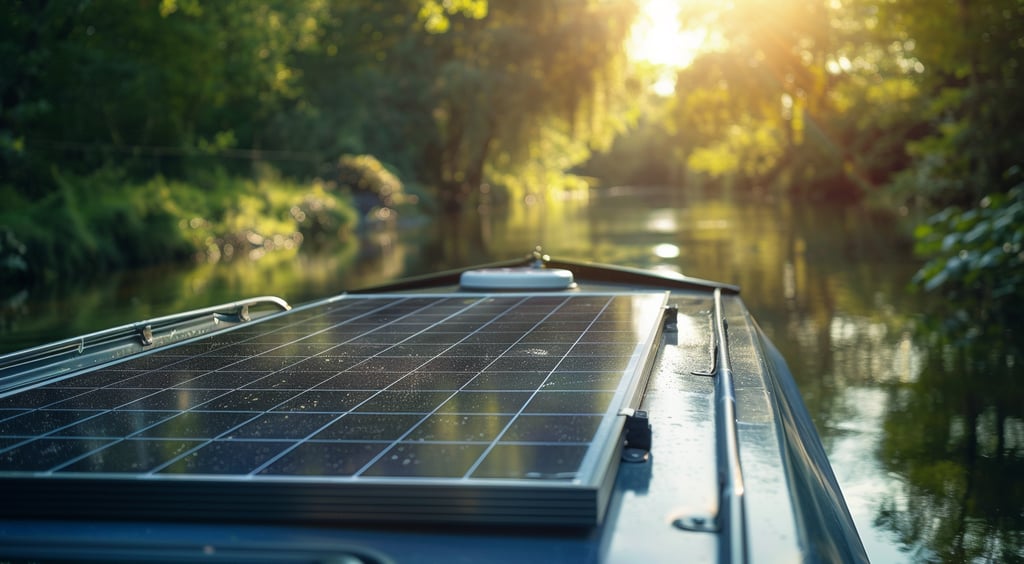
The Comprehensive Buyer's Guide to 100W Solar Panels in the UK
Looking for a 100 Watt 12 Volt monocrystalline solar panel? Our guide covers everything you need to know, from key features to the best uses for this popular panel.
Connor Braddy
7/31/20259 min read


The Ultimate Buyer's Guide to 100W Solar Panels in the UK
The 100-watt solar panel has become a cornerstone for everything from powering a campervan for an off-grid weekend to keeping the batteries on a narrowboat topped up. Its blend of affordability, manageable size, and useful power output makes it an attractive entry point into the world of solar energy.
However, to make a smart investment and avoid the common pitfalls that lead to underperforming systems and disappointment, it's crucial to look beyond the simple "100W 12V" label. This guide will walk you through the essential technology, specifications, and system components you need to understand to choose a high-quality panel and know what to realistically expect from it in the UK climate.
Section 1: Where Are 100W Panels Used? The Ideal Applications
To be clear about where a 100W panel fits into the solar landscape, it's helpful to think in terms of scale. While you might find a tiny solar cell on a calculator and a vast array of panels on a house roof, the 100W panel occupies a versatile middle ground. It is the undisputed workhorse for mobile and small-scale off-grid applications.
Here’s a clear breakdown of its primary uses:
Campervans, Motorhomes, and RVs: This is the quintessential use case. A single 100W panel, or more commonly a pair of them, is perfect for mounting on the roof of a recreational vehicle. It provides the ideal amount of power to keep a 12V leisure battery bank charged, running essential off-grid comforts like a small compressor fridge, LED lighting, a water pump, and charging devices like phones and laptops without needing to run the engine or find a mains hook-up.
Boats and Marine Vessels: For narrowboat owners, sailors, and other boaters, the 100W panel is a game-changer for energy independence on the water. Its manageable size makes it suitable for mounting on a cabin roof, often on tilting brackets to maximize the catch from the sun. Like in a campervan, it keeps the 12V system running, powering navigation equipment, lights, and small appliances.
Off-Grid Buildings and Remote Power: A 100W panel is an excellent solution for providing power to locations without a grid connection. This includes garden sheds, workshops, remote cabins, stables, or for powering automated gates and security cameras.
What a 100W Panel is NOT For:
Powering a Whole House: A single 100W panel is far too small to meet the energy demands of a typical UK home. Residential solar systems are measured in kilowatts (kW), with a standard installation being around 4kW (4,000 watts) or more—the equivalent of at least 40 of these panels.
Small Gadgets: It is vastly oversized for small electronics like calculators or garden lights, which use tiny, low-power cells designed specifically for their minimal energy needs.
In essence, if you need a reliable, independent power source for a mobile application or a small, self-contained project, the 100W panel is the perfect starting point. For larger needs, these panels are often used in multiples to create a larger array.
Section 2: The Anatomy of a Modern High-Efficiency Panel
Not all 100W panels are created equal. The technology inside the panel makes a huge difference in performance, durability, and ultimately, value for money. Here’s what defines a modern, high-quality panel.
The Monocrystalline Advantage
The heart of a solar panel is the silicon cell, and "monocrystalline" refers to the purest form available in consumer panels. These cells are sliced from a single, continuous silicon crystal, which allows electricity-generating electrons to flow more freely. This results in several key advantages:
Higher Efficiency: Monocrystalline panels have the highest efficiency ratings, typically ranging from 17% to over 23%. This means they convert more sunlight into electricity for a given area, a critical factor when roof space is limited.
Superior Performance: They generally perform better than their polycrystalline counterparts in real-world conditions, especially in the high heat of summer and the low-light conditions common in the UK.
Sleek Aesthetics: The purity of the silicon gives them a uniform, sleek black appearance that many people prefer over the speckled blue of polycrystalline panels.
For a balanced view, it's worth noting that the manufacturing process for monocrystalline silicon is more energy-intensive and creates more waste than polycrystalline production. This higher production cost is a trade-off for the panel's superior operational efficiency and performance.
PERC Technology: The Efficiency Booster
A truly modern panel will feature Passivated Emitter and Rear Cell (PERC) technology. This is a vital enhancement that adds a special reflective layer to the back of the solar cells. This layer works in three ways to squeeze more power from every sunbeam:
It reflects light: Any light that passes through the cell without being absorbed gets a second chance as it's reflected back into the cell.
It reduces electron recombination: It prevents electrons from getting "stuck" at the back of the cell, allowing more of them to be collected as electricity.
It reduces heat: It reflects longer wavelengths of light that only generate heat, helping to keep the panel cooler and more efficient on hot days.
The inclusion of PERC can boost a panel's efficiency by an absolute 1-1.5%, a significant leap in the world of photovoltaics. It has become a standard feature on any reputable panel, and its absence is a red flag that you may be looking at older, less efficient technology.
Multi-Busbar (MBB) Design: The Key to Durability
Busbars are the thin metallic strips on a cell that collect the electricity. While older panels used 3 to 5 wide busbars (3BB or 5BB), modern panels use Multi-Busbar (MBB) technology, featuring 9, 12, or even more ultra-thin wires. This offers two major benefits:
Higher Efficiency: More busbars mean a shorter distance for electrons to travel, which significantly reduces internal resistance losses. The thin, round wires also cause less shading on the cell's surface than older, flat ribbons.
Enhanced Durability: The dense grid of wires makes the cell much more resilient to microcracks that can occur from handling or environmental stress. If a crack does form, there are multiple redundant paths for the electricity to flow, preserving the panel's output.
Section 3: Decoding the Datasheet: The Numbers That Really Matter
To design a safe and effective system, you must look past the "100W" headline and understand the key electrical values on the panel's specification sheet.
The "12-Volt" Myth
The most common point of confusion is the "12-Volt" label. This is a nominal classification to show it's suitable for 12V battery systems; it does not mean the panel produces 12 volts. The actual operating voltages are much higher, and this is intentional and necessary for charging a battery. The two numbers you must know are Vmp and Voc.
Vmp (Voltage at Maximum Power): This is the panel's optimal operating voltage, where it produces the most power. For a "12V" panel, the Vmp is typically between 18V and 22V. This higher voltage is needed to overcome the battery's own voltage and resistance to effectively push a charge into it.
Voc (Open-Circuit Voltage): This is the absolute maximum voltage the panel can produce when under no load (e.g., disconnected). It's always higher than Vmp, usually 22V to 25V for a 100W panel. The Voc is a critical safety number—the maximum voltage input rating of your charge controller must be higher than the panel's Voc to prevent permanent damage.
The Impact of UK Temperatures
A panel's voltage changes with temperature, a crucial factor in the UK's variable climate. This is defined by the "Temperature Coefficient of Voltage" on the datasheet (typically around -0.3%/°C).
Cold Weather Risk: As temperatures drop, voltage rises. On a frosty -5°C morning, a panel's Voc can increase by 9% or more. A panel rated at 22V Voc could hit nearly 24V. If you've paired this with a cheap controller rated for only 25V, you risk destroying it. Always choose a controller with a voltage limit well above your panel's temperature-corrected Voc .
Hot Weather Penalty: Conversely, high heat reduces voltage and power output. On a hot summer day, the panel's operating temperature can easily reach 55°C, causing the Vmp to drop by 9% or more. This means your 100W panel will not be producing its full 100W on the hottest days of the year.
"A home energy system is a big investment in your family’s future. I’ve partnered with complex systems that last for decades and we’ve applied that same thinking to Volta. We’re not just selling a product; we’re providing a professionally engineered solution that gives you control over your energy, savings along with peace of mind."


Section 4: Building Your System: Why Your Charge Controller is Crucial
A solar panel alone is just a generator. To create a functional system, you need a charge controller. This choice will determine whether you get the power you paid for or waste a significant portion of it.
PWM vs. MPPT: The Most Important Choice You'll Make
There are two types of charge controllers: PWM (Pulse Width Modulation) and MPPT (Maximum Power Point Tracking).
PWM (The Inefficient Switch): This older, cheaper technology works like a simple switch. It connects the panel to the battery, forcing the panel's high Vmp (e.g., 18V) down to the battery's lower voltage (e.g., 13V). This process wastes all the extra voltage as heat. With a PWM controller, your 100W panel might only ever deliver 70-80W to your battery.
MPPT (The Smart Converter): This advanced controller acts as a smart DC-to-DC converter. It allows the panel to operate at its high-voltage sweet spot (Vmp) and then efficiently converts that power to the lower voltage the battery needs. As it drops the voltage, it boosts the current, ensuring almost no power is lost.
For any modern monocrystalline panel, an MPPT controller is a non-negotiable requirement to unlock its full potential. It will harvest 20-30% more power from the exact same panel compared to a PWM controller, an advantage that is even more pronounced in the cold and overcast conditions of the UK.
Section 5: A Reality Check: What a 100W Panel Actually Produces in the UK
The "100W" rating is a laboratory figure achieved under ideal Standard Test Conditions (STC). Real-world output is dictated by the UK's geography and weather, which creates a dramatic seasonal difference.
A Tale of Two Seasons
The key metric for real-world yield is Peak Sun Hours (PSH), where one PSH equals one hour of sunlight at STC intensity . The UK's high latitude means PSH varies enormously between summer and winter.
Summer Bounty: On a clear day in June, you might get 4-5 PSH. After accounting for system losses (~20%), a 100W panel could realistically generate 320-400 Wh of energy. This is enough to run a small 12V fridge, charge laptops and phones, and power LED lights.
Winter Scarcity: In December, with short days and a low sun angle, the PSH can drop below 1. Your daily yield could plummet to less than 50 Wh. This is often just enough for trickle charging a battery or powering a single light for a short time.
Experienced users on UK campervan and narrowboat forums confirm this reality, describing winter solar generation as "diddle squat" and agreeing that a single 100W panel is a 3-season solution at best, not to be relied upon for significant power needs in winter.
Conclusion: Your Checklist for a Smart Solar Investment
A 100W monocrystalline solar panel is a fantastic piece of technology and a great entry into energy independence. But to ensure you get the performance and value you expect, you need to be an informed buyer.
Treat any marketing material as the start of your research, not the end. Before you buy, demand the technical datasheet and ensure you can answer these questions:
Is it a modern panel? Does it explicitly state it uses PERC and Multi-Busbar (9BB or higher) technology?
What are the real voltages? What are the panel's Vmp and Voc ratings? Is the Voc well within the safe operating limit of your charge controller, even in freezing temperatures?
Are you using the right controller? Are you pairing the panel with a high-efficiency MPPT charge controller to avoid wasting up to 30% of its power?
Are your expectations realistic? Do you understand that the panel's output in a UK winter will be a small fraction of its summer generation, and have you planned your energy needs accordingly
By arming yourself with this knowledge, you can confidently navigate the market, build a system that performs as it should, and enjoy the benefits of solar power for years to come.

Find out more about different solar panel types
Charged up?
Ready to learn more about our battery storage systems?
Get in touch with our experts today.


Registered office address
1501 Douglass Tower, 9 Goodluck Hope Walk, London E14 0XE
020 3297 7349
hello@voltaeco.co.uk
Company number 15724376









